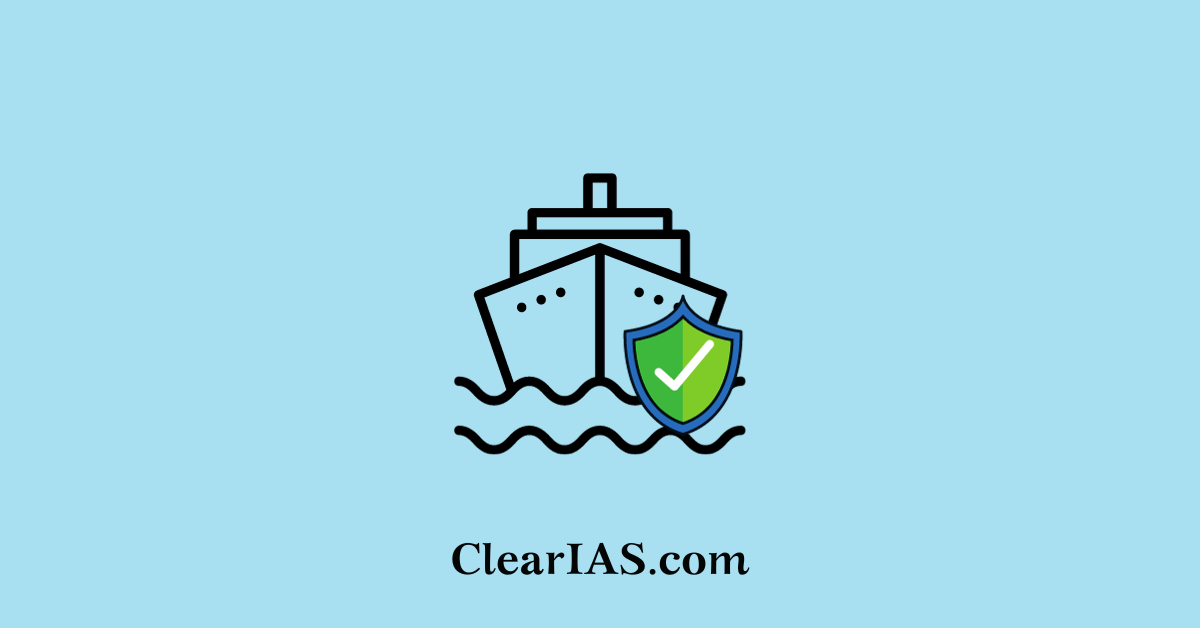
The issue of Maritime Security is being discussed at the global level. What are India’s maritime security threats? What are the initiatives taken by the government? Let us discuss this.
Given that India has a coastline that is over 7,000 km long, maritime security is a crucial component of overall national security.
Physical threats in the maritime region are no longer as prevalent as they once were because of technological advancements.
This topic is important for the international relations and internal security sections.
India’s maritime security interests
Maritime Territory
- India’s Maritime Territory is home to more than 1200 islands and a lengthy 7517 km of coastline. The Exclusive Economic Zone (EEZ) is 2.02 million square kilometers in size.
Sea Lines of Communication (SLOCs)
- The International Shipping Lanes of the Indian Ocean and the SLOCs are significant to India’s maritime security calculations because they account for 95 percent of all of its trade volume.
Maritime Economy
- In terms of fish production, India ranks second in the world. The Indian Ocean has a vast deposit of polymetallic nodules, which is a valuable source of many minerals.
Maritime Transportation
- Over 70% of the value and nearly 95% of the volume of India’s international trade is transported by sea.
Maritime Investments
- India’s financial involvement in nearby countries like Sri Lanka and the Maldives. At the moment, India operates the “Maitri” and “Bharati” research stations in Antarctica.
Indian Diaspora
- With many nations in the IOR, India has exchanged goods and maintained cultural ties. A key component of the maritime security framework is the safety and security of the Indian Diaspora living there.
India’s Historic Cultural and Trade Links in the IOR
- India has historically been the hub of trade and cultural exchange in this area thanks to its location in the Indian Ocean. Connections between India and Malaysia, Mauritius, Cambodia, and Indonesia.
Energy security
- Imports of energy are extremely important to the Indian economy. While offshore oil and gas production accounts for 80% of all domestic gas production, these imports are transported by sea.
Major challenges for maritime security
- Piracy: Piracy remains a persistent threat, particularly in the waters near the Gulf of Aden and the Indian Ocean. Indian vessels, as well as those of other nations, are vulnerable to attacks by pirates who seek ransom or engage in illegal activities. India has actively contributed to international efforts to combat piracy through naval deployments and collaborations.
- Terrorism and Insurgency: The maritime domain provides a potential avenue for terrorist activities, including the smuggling of weapons and explosives. Insurgent groups may exploit coastal areas for illegal activities, posing security challenges. Coastal states, especially those with porous borders, can be vulnerable to infiltration and illicit activities.
- Border Disputes and Territorial Waters: India has maritime border disputes, such as the longstanding issue with Pakistan over the Sir Creek area and with Bangladesh over the maritime boundary. Managing and resolving these disputes while ensuring the security of territorial waters is a complex challenge.
- Illegal, Unreported, and Unregulated (IUU) Fishing: IUU fishing poses a threat to India’s maritime security and economic interests. Foreign vessels engaged in illegal fishing activities in Indian waters can deplete marine resources, impact the livelihoods of local fishermen, and strain maritime enforcement capabilities.
- Maritime Terrorism: The potential for maritime terrorism, including attacks on ports, shipping vessels, or critical infrastructure, is a growing concern. Securing ports and maritime infrastructure against terrorist threats is crucial for India’s overall security.
- Smuggling and Trafficking: The maritime domain is often exploited for smuggling drugs, arms, and other contraband. Human trafficking and the movement of illegal migrants through maritime routes pose additional challenges. India’s coast guard and maritime security agencies are tasked with addressing these issues.
- Cybersecurity: The increasing reliance on digital technologies in the maritime sector makes it susceptible to cyber threats. Cybersecurity challenges include the protection of critical maritime infrastructure, communication networks, and data systems from cyberattacks that could compromise national security.
- Environmental Security: Protecting the marine environment is a critical aspect of maritime security. Oil spills, illegal dumping, and other environmental crimes can have far-reaching consequences for marine ecosystems and coastal communities. Combating these threats requires effective surveillance and response capabilities.
- Naval Modernization and Force Projection: India’s naval modernization efforts are aimed at enhancing its maritime capabilities. However, ensuring the readiness of a modern and technologically advanced navy, along with the ability to project power and protect maritime interests in distant waters, requires sustained investments and strategic planning.
- Climate Change Impact: Climate change poses challenges to maritime security, including the potential for altered sea routes, increased frequency and intensity of extreme weather events, and rising sea levels. These changes can affect naval operations, port infrastructure, and overall maritime resilience.
- Maritime Domain Awareness: Achieving comprehensive maritime domain awareness is an ongoing challenge. Monitoring and tracking vessels, especially in vast and busy maritime spaces, require sophisticated surveillance systems, satellite technology, and effective coordination among various agencies.
Also read: Sagar Sampark DGNSS; Maritime piracy
India’s Maritime Security Initiative
- Security and Growth for All in the Region (SAGAR), to improve relations with its maritime neighbors on the economic and security fronts.
- Project Mausam, to re-establish connections and communication channels between nations surrounding the Indian Ocean
- Indian Ocean Naval Symposium (IONS), to foster closer maritime ties between the navies of the Indian Ocean region’s coastal states.
- Indian Ocean Rim Association (IORA)– India can address maritime concerns thanks to close collaboration with IORA nations.
- Sagarmala Initiative– With the Sagarmala project, India’s coastline will be surrounded by several ports.
Way Forward
- Regional Maritime Security Framework: To address the issues, an all-encompassing security framework for the IOR must be created.
- Developing close ties with nations facing a crisis: For the unhindered and unrestricted movement of Indian trade and shipping to support ongoing economic development. Think of Saudi Arabia, Egypt, etc.
- Increase maritime exchanges between littoral states. For instance, military drills, cultural encounters, etc.
- Information Exchange: To intercept and prosecute vessels and individuals involved in illegal activity, mechanisms and protocols for the exchange of tactically crucial information and intelligence must be put in place.
- Common Operational Grid: A common operational grid between the littoral nations is necessary for the effective management of the maritime domain, particularly within a complicated region like the IOR.
- India must make improvements to its coordinated patrols with all of the littoral states. It would be necessary for ASEAN to work through SAARC, BIMSTEC, and ASEAN to fill in the gaps and establish a framework for shared maritime security.
A multidisciplinary maritime advisory body is urgently required for a country with India’s maritime resources, difficulties, and opportunities to conceptualize a vision, create plans, and keep an eye on maritime activity.
The main areas where India and other like-minded nations must coordinate their efforts are the maritime security challenges in the Indo-Pacific and South China Sea.
The South China Sea is still an important topic in the larger discussion. However, many nations, including India, are still reluctant to take direct action against China.
Article Written by: Remya






Leave a Reply